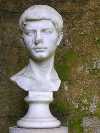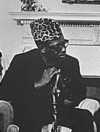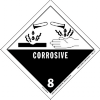Definition: (adjective) Conducive or favorable to health or well-being.
Synonyms: healthy, good for you.
Usage: She owned a cheerful vegetarian restaurant where she sold protein shakes and other salubrious refreshments.
Discuss
Source: The Free Dictionary
 In 1951, Lucille Ball became one of the first movie stars—and the first woman—to headline a television series. The prototypical situation comedy, I Love Lucy became a spectacular success, showcasing Ball’s comic energy, flair for slapstick, and chemistry with her co-star and real-life husband, Desi Arnaz, as they portrayed the zany middle-class couple Lucy and Ricky Ricardo. The program is still syndicated today. What word was once prohibited from being used on I Love Lucy?
In 1951, Lucille Ball became one of the first movie stars—and the first woman—to headline a television series. The prototypical situation comedy, I Love Lucy became a spectacular success, showcasing Ball’s comic energy, flair for slapstick, and chemistry with her co-star and real-life husband, Desi Arnaz, as they portrayed the zany middle-class couple Lucy and Ricky Ricardo. The program is still syndicated today. What word was once prohibited from being used on I Love Lucy?  The Kenka Matsuri (Roughhouse Festival) takes place October 14-15 in
The Kenka Matsuri (Roughhouse Festival) takes place October 14-15 in  Virgil was a Roman poet and the author of the Eclogues, the Georgics, and the Aeneid, widely regarded as one of the greatest long poems in world literature. The Aeneid, Rome’s national epic, tells the legendary story of the Trojan hero Aeneas, whose descendants become the founders of Rome. What later poet portrayed Virgil as the guide to Hell in his great literary classic The Divine Comedy?
Virgil was a Roman poet and the author of the Eclogues, the Georgics, and the Aeneid, widely regarded as one of the greatest long poems in world literature. The Aeneid, Rome’s national epic, tells the legendary story of the Trojan hero Aeneas, whose descendants become the founders of Rome. What later poet portrayed Virgil as the guide to Hell in his great literary classic The Divine Comedy?  Now the iconic symbol for an idea, the electric incandescent light bulb was independently produced in the late 1870s by Joseph Swan and Thomas Edison—and perhaps earlier by others. However, Edison has received the major credit for this invention because he also developed the power lines and other equipment needed for a lighting system. Financed by the likes of J.P. Morgan and the Vanderbilts, Edison achieved success using a carbon filament in his design. How do incandescent light bulbs work?
Now the iconic symbol for an idea, the electric incandescent light bulb was independently produced in the late 1870s by Joseph Swan and Thomas Edison—and perhaps earlier by others. However, Edison has received the major credit for this invention because he also developed the power lines and other equipment needed for a lighting system. Financed by the likes of J.P. Morgan and the Vanderbilts, Edison achieved success using a carbon filament in his design. How do incandescent light bulbs work?  Roundhay Garden Scene is an 1888 short film directed by French inventor Louis Le Prince, who is widely recognized as the world’s first filmmaker. Recorded at 12 frames per second, it is the earliest surviving film, predating efforts by Thomas Edison and the Lumière brothers. However, Le Prince was never able to capitalize on his innovation—he disappeared in 1890 while on his way to publicly exhibit the film. How long are the existing copies of the film?
Roundhay Garden Scene is an 1888 short film directed by French inventor Louis Le Prince, who is widely recognized as the world’s first filmmaker. Recorded at 12 frames per second, it is the earliest surviving film, predating efforts by Thomas Edison and the Lumière brothers. However, Le Prince was never able to capitalize on his innovation—he disappeared in 1890 while on his way to publicly exhibit the film. How long are the existing copies of the film?  The world’s largest annual trade show for the book publishing industry, held annually for five days in
The world’s largest annual trade show for the book publishing industry, held annually for five days in  Mobutu was the president of Zaïre—now the Democratic Republic of the Congo—from 1965 to 1997. His repressive regime resulted in corruption and poverty, while he amassed one of the largest personal fortunes in the world. He was overthrown in 1997 and died in exile in Morocco. As part of his policies, he required Africanization of all European names, changing the Congo’s name to Zaïre and his own name, Joseph Désiré Mobutu, to Mobutu Sese Seko Kuku Ngbendu Wa Za Banga, which means what?
Mobutu was the president of Zaïre—now the Democratic Republic of the Congo—from 1965 to 1997. His repressive regime resulted in corruption and poverty, while he amassed one of the largest personal fortunes in the world. He was overthrown in 1997 and died in exile in Morocco. As part of his policies, he required Africanization of all European names, changing the Congo’s name to Zaïre and his own name, Joseph Désiré Mobutu, to Mobutu Sese Seko Kuku Ngbendu Wa Za Banga, which means what?  A chemical burn occurs when living tissue is exposed to any of six types of chemical substance. Acids, bases, oxidizers, solvents, and reducing agents can all cause chemical burns without the presence of a heat source. Burns may occur right away, though they may not be immediately evident. Symptoms include itching, bleaching or darkening of the skin, burning sensations, trouble breathing, and tissue necrosis. What substances can produce chemical burns hours after contact with human skin?
A chemical burn occurs when living tissue is exposed to any of six types of chemical substance. Acids, bases, oxidizers, solvents, and reducing agents can all cause chemical burns without the presence of a heat source. Burns may occur right away, though they may not be immediately evident. Symptoms include itching, bleaching or darkening of the skin, burning sensations, trouble breathing, and tissue necrosis. What substances can produce chemical burns hours after contact with human skin?